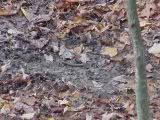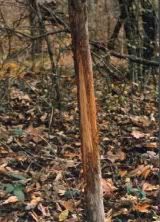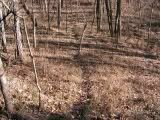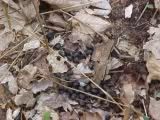 In this article we will look at the different signs deer make and there meaning. In general signpost communication is both, a visual and olfactory marker for other deer. Signposts include both rubs and scrapes. The deer uses these signposts to either, convey a message to other deer or as an orientation marker, similar to directional signposting we use on our roads. A smart hunter will learn how to interpret and understand deer sign. Understanding deer sign is as important to a successful hunter as understanding a deer’s behavior in correlation to food sources, topography, seasonal and environmental changes.
In this article we will look at the different signs deer make and there meaning. In general signpost communication is both, a visual and olfactory marker for other deer. Signposts include both rubs and scrapes. The deer uses these signposts to either, convey a message to other deer or as an orientation marker, similar to directional signposting we use on our roads. A smart hunter will learn how to interpret and understand deer sign. Understanding deer sign is as important to a successful hunter as understanding a deer’s behavior in correlation to food sources, topography, seasonal and environmental changes. Scrapes
ScrapesA scrape is an area of exposed earth up to 6 or 8 feet in diameter that a deer has swept clear of leaves, twigs and other debris with its front feet. Deer leave their scent at scrapes in several different manners. They urinate in it and as they step it in leave glandular scent behind. Despite popular believe that only bucks make and use scrapes, does make and use scrapes too. One way to view a scrape is that it is a check in station. Deer passing through the area will check in or visit the scrape to leave their scent (urine) and see what other deer have recently been in the area. Both bucks and does will visit active scrapes. There are several kinds of scrapes.
Primary Scrape
A large scrape made in an area that does frequent or where several doe trails converge. A buck will often urinate in these scrapes and leave other glandular scents in the area. These scrapes could be described as boundary signposts. For hunting purposes these scrapes are not much use to me other than that they tell me that this area holds a dominant buck.
Satellite Scrape
A scrape made by a mature buck along edge cover or buck travel corridors. Some hunters believe that these secondary scrapes are used mostly by the buck population to keep track of each other. However, I have witnessed many times that does too urinate in these scrapes to “advertise” their estrus status to passing bucks. Several satellite scrapes along an edge are called a scrape line. Generally, I do not hunt scrapes but they do tell me by increased activity (scraping) when the rut is approaching.
Primary and Satellite scrapes are always placed on edges and in plain sight, they are meant to be very visible. These scrapes can always be next to a tree trunk or bush with an overhanging branch or two about four feet of the ground. Typically the branch above the scrape will be chewed on by the deer to leave yet another scent marks. In addition bucks will rub their heads on these braches and by doing so deposit glandular scent on the branches.
The scrapes can appear from the size of a dinner plate to several feet in diameter. The size of the scrape is no indication of the size of the buck that made the scrape.
Random Scrape
A scrape made randomly by a buck along a trail. These secondary scrapes feature not always a overhead licking branch. Most hunters believe that most satellite scrapes are made by immature bucks and are never revisited by the deer that made the scrape or any other deer. Such scrapes are, also made by large bucks in the pre-rut out of frustration. The pre-rut is a very tense time for bucks when they start to become more aggressive and intolerant of each other, the does are not in estrus yet and so bucks let off some steam by making these “frustration” scrapes and trash their horns against brush and saplings. Again, for hunting proposes these scrapes are of no value to me other than that they tell me that there are bucks in the area.
Mock Scrape
A mock scrape is one that has been made by a hunter in an area that deer frequent. Some hunters will visit mock scrapes year around and freshen them with commercial deer scent. The purpose of a mock scrape is to create a signpost that brings deer closer to your stand location and give the resident bucks the impression that another buck invaded their territory. By making a mock scrape the hunter has to pay attention to deer travel. It makes no sense to try and attract a buck with a mock scrape in an area where he doesn’t travel. No deer will go out of its travel way to come to a scrape.
Active Scrape
An active scrape is one that is being regularly maintained by multiple deer. A scrape that is not regularly visited is referred to as an in-active scrape. An active scrape has fresh turned soil and is free of debris such as leafs and twigs and it has a strong smell of urine. When a hunter approaches a scrape to “juice” it up with deer urine based scent he should use utmost caution not to leave any human odors near the scrape. Most hunters use rubber cloves to handle scrapes and make sure that they do not step into the actual scrape.
 Rubs
RubsA rub is an area on a tree 1 to 3 feet off the ground where a buck has rubbed the bark off the tree by using it to remove the velvet, polish his antlers and strengthen his neck muscles. It is often said that all bucks rub little trees, but only big bucks rub big trees, however I have made no observations to support such claims. I have seen small bucks rubbing on large trees too. One basic rule should be applied to rubs. While a big buck can make small and large rubs, a small buck only makes small rubs. In my opinion, there are only three types of rubs; incidental, cluster and sign post rubs.
Incidental Rubs
Incidental are just as the name implies. Incidental. They mean nothing and have no value for our scouting purpose. Incidental rubs appear early in the season and are numerous. They are not large and appear either as singles or in groups of three to four. Some hunters make the mistake of believing that these rubs are made by bucks to remove the velvet from their antlers. However, after my observations I believe this is not true. To be honest with you I have no clue as to why bucks make this rubs. Perhaps they make them to relive some the tension and aggression as bachelor groups begin to dissolve and bucks begin to test their strength on each other and get ready for the coming of the rutting phase. What ever it is I do know that these rubs are of no value to me in planning my hunting strategy.
Cluster Rubs
I do not know or this is the proper name but that is what I call these rubs because they appear in clusters. There may be as many as a dozen or more of them in one small area and always in clusters. They may vary in size from a small sapling to a thigh-sized tree. These rubs provide me with slightly more information than the incidental rubs. In fact, I am convinced that these cluster rubs are made by more than just one buck. Because of that they are an indication that the area is frequented by more than just one buck. These areas therefore deserve some consideration as possible stand sites. My observation has been that such cluster rubs seem to appear more in areas with regular to heavy doe traffic. You find them often near or around doe feeding and bedding areas and that is what makes these rubs interesting for me. Make no mistake about it. Come the rutting season these bucks that made this rubs will all hang around by the girls. I have always maintained, if you want to kill a big buck stay with the does because the big boys will too.
Sign Post Rubs
These are the rubs I am looking for and that in my opinion have the highest value in terms of placing my stand or patterning a buck. These rubs are exactly what the name implies – sign posts. This rubs convey information, not only to the bucks, but also to the woods savvy hunter. These rubs are like street signs for us. Like a stop sign that tells us to stop or a warning sign tells us of a dangerous situation ahead. The sign post rub tells the buck the same thing. It provides him with information. If we as hunters can interpret that information correctly, we can plan a strategy that ultimately could bring a buck right close up to us.
It may not be evident immediately what a sign post rub means, it often takes some real detective work to figure that out. Let me give you an easy explanation of how they work. You need to understand why a buck needs these sign posts and does do not. Does travel in large family groups during most of the year. These social groups create large and good visible trails. The does easily can follow these trails, even at night, they also know exactly where each of these trails leads too. It’s a bit like with you and me, we know our way from our home to the next grocery store or to our place of work even if all the road signs would be removed from that route.
Bucks, on the other hand, spend the most important part of the year as loners, or in the company of a single subordinate buck. Buck trails are insignificant if they can be seen at all. Bucks travel a great deal and often cross into strange and unfamiliar territory in the search of receptive does or new territory. As with us humans, if we go some place we are unfamiliar with we need to relay on a road map and signs. It’s no different with bucks and it is here where the sign post rub guides the bucks.
Sign post rubs are usually large and good visible, they are also regularly freshened up during the fall moths and may be used by more than one buck.
By far the easiest rub to understand is the crossing point rub. Look for such rubs near crossings such as along roadsides, fence lines, streams, field edges and other edges. These rubs tell the bucks, “Here is a crossing”. It is also common to find a line of rubs, “rub line” leading to these sign posts. Often there is no or only a very faint trail leading to such a sign post rub or along a rub line. Single bucks do not make large trails. However, if you look a little bit around in the area, preferably upwind from the signpost rubs, you will discover in many instances a significant doe trail.
A sign post rub can tell us much more than just where a given buck may travel or cross a certain point. Such rubs also can tell you from which direction a buck approaches and where he’s heading, even the time of day and frequency of travel.
The bucks always rub the tree on the say of the direction they come from. The marred side of the tree points to the tail end of the buck. If you are facing the rubbed side of a tree you are facing in the direction the buck is going. If you follow the direction and keep your eyes peeled you may see other rubs in a line. This line has not necessary to be straight. During the pre-season scouting follow this rub lines and knowing where these lead too will let you determine at what time of the day the bucks most likely travel this route. If a rub leads to a feeding area it is likely that the buck travels this rub line in the late afternoon. A rub line running along a ridge top may most likely be a midday travel route when the buck searches for does in heat.
 Deer Tracks
Deer TracksThe size of a deer track will help you to determine the size of the deer. As a deer grows, their feet will grow accordingly. Big mature bucks will leave big and deep tracks. In soft ground the dewclaws will show on both bucks and does. Rounded tips on hoofs are a result of hoof wear usually due to rocky or other abrasive surfaces and have little to do with weather the deer is a buck or a doe.
When a deer walks, they will place their back hoof in the track of their front hoof. If the second track falls slightly to the outside of the first, it is probably a doe because a doe's hindquarters are wider than her chest. The wider hindquarters of a doe are required for giving birth. If the second track falls slightly to the inside and short of the first track, then it is probably a buck track since a buck's chest is wider than his hindquarters and his body is longer.
 Deer Trails
Deer TrailsThink of deer trails like of our highway system. Deer trails are always coming from somewhere and going somewhere. Deer trails lead to food sources, water, bedding areas or connecting with other trails. Some trails can be as wide as a walkway while others are so faint that you can barely see them. Deer do not use all the trails at will whenever they want, there has to be a purpose for the deer to use any given trail. During the year deer use different trails at different times and for different purposes. To find out which trails the deer will use during different times in a hunting season and to plan hunting strategies that work the hunter has to find out which trails will be used by the deer at the time he hunts. What trails the deer will be using at any given time has to be determined by finding out what’s on either end of the trail or what they are connected to.
 Deer Droppings
Deer DroppingsDeer droppings don’t tell me much, other than that at one time or other a deer walked here. There are only two incidents when I get exited about droppings. One is when I find fresh deer droppings plus other fresh sign that tells me that this is an active area full of deer that I need to hunt here right now. But as I said, there has to be other sign indicating that the deer are using the area, deer droppings alone don’t excite me at all. The second occasion is in the late season when I track deer in the snow with my bow or muzzleloader. Seeing fresh deer droppings, perhaps still steaming, puts me on high alert. This could mean that the deer is only a short distance ahead of me.
In future articles we will look a bit closer at different deer sign and how I use these signs to plan my hunting strategies.
If you have any questions or comments about this article please use the comment feature below.

1 comment:
Great info, thanks.
Post a Comment